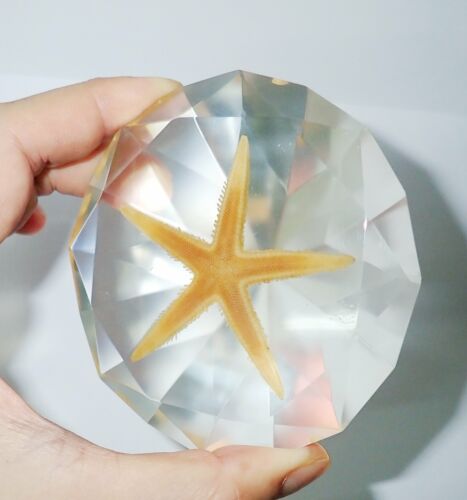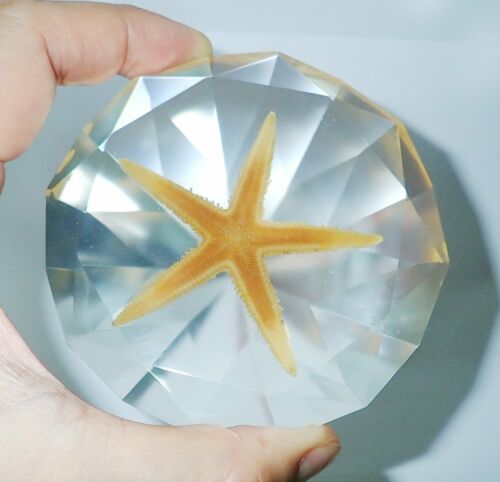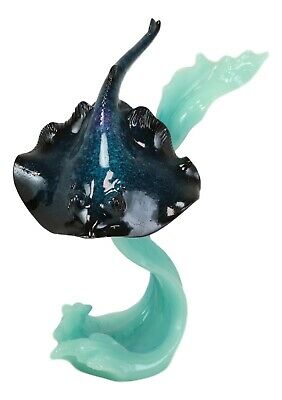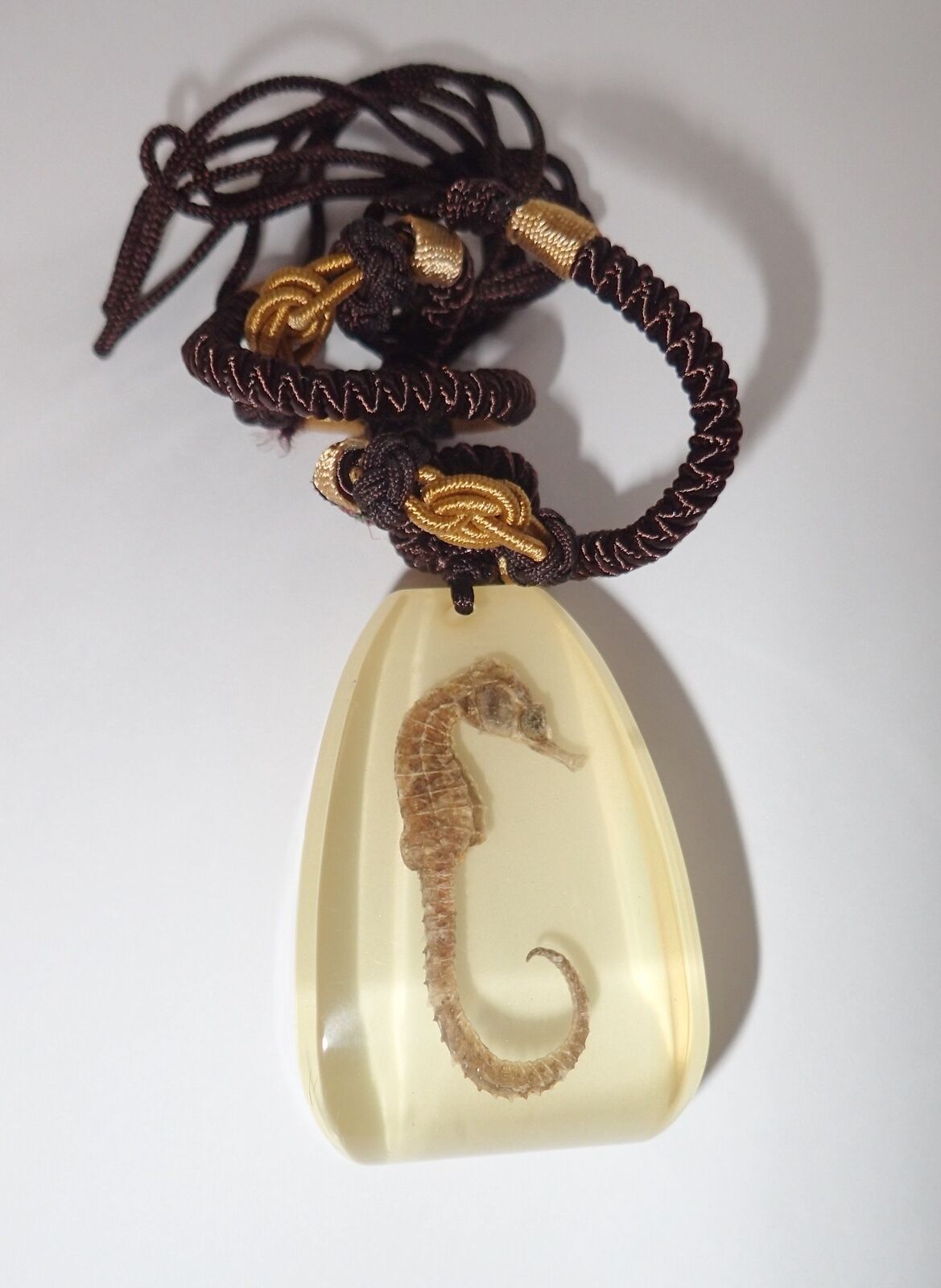-40%
Starfish Flatbottom Seastar in 92 mm Diamond Cut Cone Shape Paperweight DDS5
$ 12.13
- Description
- Size Guide
Description
Diamond cut done shape paperweight (DDS5 - 92 mm)Real Starfish (Flatbottom Seastar - Asterias amurensis) specimen encased in clear lucite material. The specimen is crystal clear, transparent and indestructible. Safe, authentic and completely unbreakable product put the Starfish right at your fingertips!
Anyone can safely explore the Starfish from every angle.
Length of the starfish is 6.8 cm (2.7 inch).
Diameter of the come is 9.2 cm (3.6 inches) and height is 6.2 cm (2.4 inch).
Weight of the come is 200 gram.
Nature & Science
https://stores.ebay.com/Gao-Fu-Collectibles
Starfish Flatbottom Seastar in 92 mm Diamond Cut Cone Shape Paperweight DDS5
Diamond cut done shape paperweight (
DDS5 - 92 mm
)
Real
Starfish (Flatbottom Seastar -
Asterias amurensis
)
specimen encased in clear lucite material. The specimen is crystal clear, transparent and indestructible. Safe, authentic and completely unbreakable product put the Starfish right at your fingertips!
Anyone can safely explore the Starfish from every angle.
Length of the starfish is 6.8 cm (2.7 inch).
Diameter of the come is 9.2 cm (3.6 inches) and height is 6.2 cm (2.4 inch).
Weight of the come is 200 gram.
This is a handmade real animal specimen craft. Each one will be a bit different (specimen size, color and posture) even in the same production batch.
The pictures in the listing are just for reference as we are selling multiple pieces with same pictures.
***
Flatbottom Seastar -
Asterias amurensis
Order: Forcipulatida
Family: Asteriidae
Genus:
Asterias
Taxonomic name:
Asterias amurensis
Common names:
Flatbottom seastar, Japanese Seastar, Japanese starfish, Nordpazifischer Seestern (German), North Pacific seastar, northern Pacific seastar, purple-orange seastar
Organism type:
sea star
Originally found in far north Pacific waters and areas surrounding Japan, Russia, North China, and Korea, the northern Pacific seastar (Asterias amurensis) has successfully invaded the southern coasts of Australia and has the potential to move as far north as Sydney. The seastar will eat a wide range of prey and has the potential for ecological and economic harm in its introduced range. Because the seastar is well established and abundantly widespread, eradication is almost impossible. However, prevention and control measures are being implemented to stop the species from establishing in new waters.
Description
Asterias amurensis
(northern Pacific seastar) can grow upto 50 cm in diameter. It is yellow with red and purple pigmentation on its five arms, and a small central disk. Its distinctive characteristic is its upturned tips which are its identification key when compared to similar starfish. The undersides are completely yellow and arms are unevenly covered with small, jagged-edged spines. These spines line the groove in which the tube feet lie, and join up at the mouth in a fan-like shape.
Similar Species
Pisaster brevispinus, Pisaster giganteus, Pisaster ochraceus
Occurs in:
estuarine habitats, marine habitats
Habitat description
While
Asterias amurensis
(northern Pacific seastar) prefers waters temperatures of 7-10°C, it has adapted to warmer Australian waters of 22°C. It is typically found in shallow waters of protected coasts and is not found on reefs or in areas with high wave action. The starfish is capable of tolerating many temperatures and wide ranges of salinities. It is often found in estuaries and on mud, sand or rocky sheltered areas of intertidal zones. The maximum temperature for
Asterias amurensis
is 25°C and the minimum is 0°C. The salinity range for this species is between 18.7 and 41ppt, while the maximum depth at which individuals have been found is 220m.
General impacts
Asterias amurensis
(northern Pacific seastar) has the potential to establish large populations in new areas. Estimates made in Port Philip Bay (where they were first detected), indicate that numbers reached as much as 12 million individuals in two years. In their native range they are known to go through 'bust and boom' cycles reaching high abundance and then rapid decline.
The northern Pacific seastar is a voracious feeder, preferring mussels, scallops and clams. It will eat almost anything it can find, including dead fish and fish waste. The seastar is considered a serious pest of native marine organisms. The seastar is also considered a mariculture pest, settling on scallop longlines, spat bags, mussel and oyster lines and salmon cages.
In Japan seastar outbreaks cost the mariculture industry millions of dollars.
Uses
No valuable human use has been documented. Hunting incentives have been suggested, such as catching and drying as souvenirs.
Notes
In its native Japan,
Solaster paxillatus
(a sunstar) has been noted as a predator of
Asterias amurensis
(northern Pacific seastar). The predation of
A. amurensis
by king crabs in Alaskan aquaria has also been observed. The size of prey eaten by
A. amurensis
usually equals the length of the seastar's arm. Organisms that compete with
A. amurensis
include:
Uniophora granifera
,
Coscinasterias muricata
and
Odobenus rosmarus divergens
(Pacific walruses).
Geographical range
Native range
: Native to Japan, North China, Korea, Russia, and far North Pacific waters.
Introduction pathways to new locations
Live food trade:
Asterias amurensis
(northern Pacific seastar) can be transmitted
via
seawater in live fish trade
Ship ballast water:
Asterias amurensis
(northern Pacific seastar) larvae can be distributed through ballast water
Ship/boat hull fouling:
Asterias amurensis
(northern Pacific seastar) can be distributed on ship hulls
Translocation of machinery/equipment:
Asterias amurensis
(northern Pacific seastar) can be unintentionally transferred
via
recreational boats
Transportation of habitat material:
Asterias amurensis
(northern Pacific seastar) settles on scallop longlines, spat bags, mussel and oyster lines, and salmon cages.
Local dispersal methods
Water currents:
Asterias amurensis
(northern Pacific seastar) larvae are transported in water currents.
Management information
Asterias amurensis
is identified as one of the ten most damaging potential domestic target species, based on overall impact potential (economic and environmental). A hazard ranking of potential domestic target species based on invasion potential from infected to uninfected bioregions identifies
Asterias amurensis
as a 'medium priority species' - these species have a reasonably high impact/or invasion potential.
Nutrition
Asterias amurensis
(northern Pacific seastar) eats bivalves, gastropod molluscs, barnacles, crabs, crustaceans, worms, echinoderms, ascidians, sea urchins, sea squirts and other seastars, including conspecifics if food source becomes exhausted.
Reproduction
Asterias amurensis
(northern Pacific seastar) reproduces sexually and asexually. Spawning occurs between July and October in Australian waters . The female seastar is capable of carrying up to 20 million eggs. Fertilisation is external and larvae remains in a planktonic stage for up to 120 days before settling and metamorphosing into juvenile starfish. Sperm half life at 10°C > 2 hours, at 17°C < 30 minutes.
Lifecycle stages
Juvenile
Asterias amurensis
(northern Pacific seastars) grow up to 6mm per month in the first year and continue to grow 1 - 2mm per month until maturity. The female is able to reproduce at about 12 months of age, when they are around 10cm in diameter.
This species has been nominated as among 100 of the "World's Worst" invaders.
Item Specifics
Modified Item
No
Country/Region of Manufacture
China
Handmade
Yes
Animal Class
Starfish
Material
Resin
Type
Collector Plate
Payment
Payment: By Paypal
Shipping cost
Free shipping cost.
We send the goods to USA, Canada, UK, Australia, New Zealand, EU countries and some other European and Asian countries by E-express, a kind of fast postal service by Hong Kong Post. It usually takes about 6 to 10 working days for delivery.
We send the goods to other countries by registered airmail and will take about 8 to 14 working days for delivery.
Return policy
Returns: We accept returns with any reason in 30 days.
Messages
We will answer buyer messages within 24 hours during working days.
Nature & Science
https://stores.ebay.com/Gao-Fu-Collectibles
Shop Category
Store Home
Insect & Animal
◈ Magnet
◈ Stapler
▷ Bracelet
♢ Transparent Clear
♢ Glow in the Dark
▷ Pendant/Necklace
♢ Clear
♢ Glow
◈ Table Display
◈ Bangle
▷ Sphere
♢ 2 cm
♢ 5 - 6 cm
♢ 7.5 - 8.5 cm
♢ Shift Knob
◈ Ring
▷ Hanger / Cell Phone Charm
♢ Clear
♢ Glow
◈ Dome paperweight
◈ Animal Skeleton
◈ Life Cycle
◈ Butterfly
▷ Scorpion
♢ Golden Scorpion
♢ Black Scorpion
♢ Other Scorpion
▷ Spider
♢ Tarantula Spider
♢ Other Spiders
♢ Spiny Spider
▷ Insect specimen - Beetle
♢ Ladybird Beetle
♢ Unicorn Beetle
♢ Dung Beetle
♢ Rose Chafer Beetle
♢ Snout Beetle
♢ Stag Beetle
♢ Longhorn Beetle
♢ Scarab Beetle
♢ Others
♢ Ground Beetle
♢ Leaf Beetle
◈ Collection Set
▷ Keychain
♢ Clear
♢ Glow in the dark
◈ Centipede
▷ Snake
♢ Snake
♢ Snake Skeleton
◈ Labelled specimen
▷ Marine Animal
♢ Crab
♢ Seahorse
♢ Starfish
♢ Coral
♢ Turtle
♢ Shrimp / Prawn
♢ Other sea animal
◈ Computer Mouse
◈ Ashtray
▷ Cabochon
♢ Round - 35 mm / 36 mm
♢ Oval - 18x25 mm
♢ Oval - 30x40 mm
♢ Others
♢ Oval - 12x18 mm
♢ Round 23.5 mm / 25 mm
♢ Round 38.5 mm
♢ Round 38 mm
♢ Round 19 mm
♢ Round 13 mm
◈ Insect Pen
◈ Locust / Grasshopper
◈ Bee / Wasp / Hornet
◈ Bottle Opener
◈ Bugs
◈ Other animals
◈ Ant
◈ Cicada
◈ Other insects
◈ Earring
Jewelry items
◈ Cabochon
Framed specimens
Shark Teeth
◈ Shark Tooth Keychain
◈ Necklace / Bracelet
Flower,plant
▷ Leaf
♢ Labelled specimen
♢ Leaf
◈ Flower
◈ Bean/Seed/Nut
◈ Life cycle
◈ Root
◈ Collection set
◈ Laminated Specimen
Paper Cuts
◈ Large Set
▷ Small Set
♢ Year of Animals/Zodiac Animals
♢ Butterfly
♢ Animals
♢ People/Figures
♢ Flower
♢ Scenery/Landscape
♢ Fortune Item
♢ Decoration Item
♢ Animal -- Horse
♢ Animal -- Bird
♢ Animal -- Fish
♢ Animal -- Cow
♢ Animal -- Panda
♢ Animal -- Dragon
♢ Animal -- Snake
♢ Animal -- Monkey
♢ Animal -- Chicken
♢ Animal -- Insect
♢ Animal - Mouse
♢ Animal -- Cat
◈ Single Piece
▷ Heros of Water Margin
♢ Single Piece
♢ Whole Set & Sub Sets
◈ Bookmark
Star Ruby & Sapphire
▷ Ruby -- Opaque Cabochon
♢ Oval
♢ Heart
♢ Round
♢ Square
♢ Pear
♢ Marquise
♢ Triangular
▷ Ruby -- Transparent Cabochon
♢ Oval
♢ Round
♢ Heart
▷ Sapphire -- Opaque Blue Cab
♢ Oval
♢ Heart
♢ Round
♢ Pear
♢ Marquise
♢ Square
◈ Sapphire--Transparent Orange
◈ Sapphire -- Opaque White Cab
◈ Sapphire -- Transparent Purple
◈ Sapphire -- Transparent Yellow
◈ Jewelry items
Fossils
▷ Trilobites
♢ Ductina vietnamica
♢ Coronocephalus jastrowi
♢ Arthricocephalus granulus
♢ Redlichia chinensis
◈ Plants
◈ Seashell / Sea Animals
◈ Insect
◈ Animal tooth
◈ Coral
Lapis Lazuli Stone
▷ Rough Stone
♢ Polished Stone
♢ Unpolished Rough Stone
◈ Cabochon
◈ Carvings
Stone Carving
◈ Lapis Lazuli Stone
◈ Other stone
◈ Tiger Eye Stone
◈ Quartz
Mineral, crystal, gemstone
◈ Kunzite Rough Stone
◈ Cinnabar Specimen
◈ Ruby stone
◈ Desert Agate
◈ Aquamarine
◈ Pyrite
▷ Jasper stone
♢ Red Jasper
♢ Desert Jasper
◈ Amazonite
◈ Sapphire stone
◈ Epidote
▷ Clear Quartz Crystal
♢ Rough crystal
▷ Tiger Eye Stone
♢ Polished stone
♢ Carvings
▷ Agate
♢ Agate stone specimen
◈ Garnet
◈ Other stones
◈ Opal
◈ Tourmaline
◈ Fluorite
◈ Moonstone
◈ Jadeite Stone
◈ Stone Mix - Collection Set
◈ Citrine
◈ Amethyst
◈ Prehnite
◈ Peridot
◈ Topaz
Meteorite & Tektite, Moldavite
▷ Black Tektite
♢ Rough stone specimen
♢ Pendant
♢ Cell phone strap
Turquoise
▷ Turquoise substitute stone
♢ Rough stone
◈ Cabochon
Fish items
◈ Fish specimen
◈ Fish skeleton
◈ Fish keychain
Bookmark
▷ Butterfly on the leaf
♢ Laminated - small
Hot Item
Paper Cuts Dragon Set 8 colorful small single pieces CHEN 1 packet Lot
USD 10.00
Large Tarantula Spider Golden Earth Tiger 110x43x30 mm Block Education Specimen
USD 20.00
Powdered Cinnabar Crystal Native Pigment Material 50 gram Lot
USD 20.00
Natural Ruby Rough Stone 0.4 to 4 g Small Nugget from Tanzania 70 gram Lot
USD 15.00
Chinese Paper Cuts 8 Flying Butterfly Set 8 Small Colorful Pieces 1 packet Lot
USD 10.00
New List Item
Turquoise Stone Pear 22x14 mm Flat Cabochon 125 Carat 12 pieces 25 gram
USD 30.99
Turquoise Stone Flat Free Form Cabochon 145 Carat 2 pieces 29 gram Lot D
USD 22.99
Turquoise Stone Flat Free Form Cabochon 180.5 Carat 4 pieces 36.1 gram Lot B
USD 27.99
Polished Red Agate Stone 0.5 to 2 g Very Small size pieces 400 gram Lot
USD 21.99
Large Clear Key Ring Common Octopus SK12 Octopus vulgaris Specimen
USD 14.99
Picture
Custom Item
Starfish Flatbottom Seastar in 92 mm Diamond Cut Cone Shape Paperweight DDS5
Diamond cut done shape paperweight (
DDS5 - 92 mm
)
Real
Starfish (Flatbottom Seastar -
Asterias amurensis
)
specimen encased in clear lucite material. The specimen is crystal clear, transparent and indestructible. Safe, authentic and completely unbreakable product put the Starfish right at your fingertips!
Anyone can safely explore the Starfish from every angle.
Length of the starfish is 6.8 cm (2.7 inch).
Diameter of the come is 9.2 cm (3.6 inches) and height is 6.2 cm (2.4 inch).
Weight of the come is 200 gram.
This is a handmade real animal specimen craft. Each one will be a bit different (specimen size, color and posture) even in the same production batch.
The pictures in the listing are just for reference as we are selling multiple pieces with same pictures.
***
Flatbottom Seastar -
Asterias amurensis
Order: Forcipulatida
Family: Asteriidae
Genus:
Asterias
Taxonomic name:
Asterias amurensis
Common names:
Flatbottom seastar, Japanese Seastar, Japanese starfish, Nordpazifischer Seestern (German), North Pacific seastar, northern Pacific seastar, purple-orange seastar
Organism type:
sea star
Originally found in far north Pacific waters and areas surrounding Japan, Russia, North China, and Korea, the northern Pacific seastar (Asterias amurensis) has successfully invaded the southern coasts of Australia and has the potential to move as far north as Sydney. The seastar will eat a wide range of prey and has the potential for ecological and economic harm in its introduced range. Because the seastar is well established and abundantly widespread, eradication is almost impossible. However, prevention and control measures are being implemented to stop the species from establishing in new waters.
Description
Asterias amurensis
(northern Pacific seastar) can grow upto 50 cm in diameter. It is yellow with red and purple pigmentation on its five arms, and a small central disk. Its distinctive characteristic is its upturned tips which are its identification key when compared to similar starfish. The undersides are completely yellow and arms are unevenly covered with small, jagged-edged spines. These spines line the groove in which the tube feet lie, and join up at the mouth in a fan-like shape.
Similar Species
Pisaster brevispinus, Pisaster giganteus, Pisaster ochraceus
Occurs in:
estuarine habitats, marine habitats
Habitat description
While
Asterias amurensis
(northern Pacific seastar) prefers waters temperatures of 7-10°C, it has adapted to warmer Australian waters of 22°C. It is typically found in shallow waters of protected coasts and is not found on reefs or in areas with high wave action. The starfish is capable of tolerating many temperatures and wide ranges of salinities. It is often found in estuaries and on mud, sand or rocky sheltered areas of intertidal zones. The maximum temperature for
Asterias amurensis
is 25°C and the minimum is 0°C. The salinity range for this species is between 18.7 and 41ppt, while the maximum depth at which individuals have been found is 220m.
General impacts
Asterias amurensis
(northern Pacific seastar) has the potential to establish large populations in new areas. Estimates made in Port Philip Bay (where they were first detected), indicate that numbers reached as much as 12 million individuals in two years. In their native range they are known to go through 'bust and boom' cycles reaching high abundance and then rapid decline.
The northern Pacific seastar is a voracious feeder, preferring mussels, scallops and clams. It will eat almost anything it can find, including dead fish and fish waste. The seastar is considered a serious pest of native marine organisms. The seastar is also considered a mariculture pest, settling on scallop longlines, spat bags, mussel and oyster lines and salmon cages.
In Japan seastar outbreaks cost the mariculture industry millions of dollars.
Uses
No valuable human use has been documented. Hunting incentives have been suggested, such as catching and drying as souvenirs.
Notes
In its native Japan,
Solaster paxillatus
(a sunstar) has been noted as a predator of
Asterias amurensis
(northern Pacific seastar). The predation of
A. amurensis
by king crabs in Alaskan aquaria has also been observed. The size of prey eaten by
A. amurensis
usually equals the length of the seastar's arm. Organisms that compete with
A. amurensis
include:
Uniophora granifera
,
Coscinasterias muricata
and
Odobenus rosmarus divergens
(Pacific walruses).
Geographical range
Native range
: Native to Japan, North China, Korea, Russia, and far North Pacific waters.
Introduction pathways to new locations
Live food trade:
Asterias amurensis
(northern Pacific seastar) can be transmitted
via
seawater in live fish trade
Ship ballast water:
Asterias amurensis
(northern Pacific seastar) larvae can be distributed through ballast water
Ship/boat hull fouling:
Asterias amurensis
(northern Pacific seastar) can be distributed on ship hulls
Translocation of machinery/equipment:
Asterias amurensis
(northern Pacific seastar) can be unintentionally transferred
via
recreational boats
Transportation of habitat material:
Asterias amurensis
(northern Pacific seastar) settles on scallop longlines, spat bags, mussel and oyster lines, and salmon cages.
Local dispersal methods
Water currents:
Asterias amurensis
(northern Pacific seastar) larvae are transported in water currents.
Management information
Asterias amurensis
is identified as one of the ten most damaging potential domestic target species, based on overall impact potential (economic and environmental). A hazard ranking of potential domestic target species based on invasion potential from infected to uninfected bioregions identifies
Asterias amurensis
as a 'medium priority species' - these species have a reasonably high impact/or invasion potential.
Nutrition
Asterias amurensis
(northern Pacific seastar) eats bivalves, gastropod molluscs, barnacles, crabs, crustaceans, worms, echinoderms, ascidians, sea urchins, sea squirts and other seastars, including conspecifics if food source becomes exhausted.
Reproduction
Asterias amurensis
(northern Pacific seastar) reproduces sexually and asexually. Spawning occurs between July and October in Australian waters . The female seastar is capable of carrying up to 20 million eggs. Fertilisation is external and larvae remains in a planktonic stage for up to 120 days before settling and metamorphosing into juvenile starfish. Sperm half life at 10°C > 2 hours, at 17°C < 30 minutes.
Lifecycle stages
Juvenile
Asterias amurensis
(northern Pacific seastars) grow up to 6mm per month in the first year and continue to grow 1 - 2mm per month until maturity. The female is able to reproduce at about 12 months of age, when they are around 10cm in diameter.
This species has been nominated as among 100 of the "World's Worst" invaders.
Payment
Payment: By Paypal
Shipping cost
Free shipping cost.
We send the goods to USA, Canada, UK, Australia, New Zealand, EU countries and some other European and Asian countries by E-express, a kind of fast postal service by Hong Kong Post. It usually takes about 6 to 10 working days for delivery.
We send the goods to other countries by registered airmail and will take about 8 to 14 working days for delivery.
Return policy
Returns: We accept returns with any reason in 30 days.
Messages
We will answer buyer messages within 24 hours during working days.
Copy rights of https://stores.ebay.com/Gao-Fu-Collectibles. All right reserved.




















